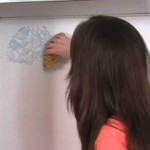Sponge Painting Techniques
Posted by admin | Under Home painting Monday Apr 12, 2010 Sponge painting is one of the easiest Faux paintings to do. I will show you how simple it really is. Out of all Faux finishing techniques sponge painting is one of the most basic. All you need is two different painting colors, glazing liquid, sea sponge and paper towels. Don’t try using your regular sponge for this technique because a regular sponges holes are too uniform. A sea sponge has random holes which will give a much better texture. When choosing which colors to use the safest choices is to use the same color in different tones but if you want to be more daring try using contrasting colors.
Sponge painting is one of the easiest Faux paintings to do. I will show you how simple it really is. Out of all Faux finishing techniques sponge painting is one of the most basic. All you need is two different painting colors, glazing liquid, sea sponge and paper towels. Don’t try using your regular sponge for this technique because a regular sponges holes are too uniform. A sea sponge has random holes which will give a much better texture. When choosing which colors to use the safest choices is to use the same color in different tones but if you want to be more daring try using contrasting colors.
To start sponge painting
You need to first apply your base coat. Paint the base coat on your wall as you usually would when you would paint your wall. Let the base coat completely dry. Once your base coat is dry mix your next color with the glaze. I suggest using two parts glazing liquid to one part paint. For a darker look use less glaze and more paint. After making your glaze mixture, layout some extra paper towels. Get your sponge wet and ring it out completely. Then dip your sponge into the glaze mixture. Wipe the sponge off on the side of your paint pan then dab the sponge onto your paper towel once to get off extra paint.
When sponging make sure you start in the least most noticeable corner of your room. Where you start and finish will leave a seem and you don’t want people to notice that. Also make sure that you always start at the top of your wall instead of the bottom otherwise you might drip on places that you have already sponged.
To sponge, lightly dab your sponge on the wall. Then rotate the sponge a bit and lightly dab the wall again making sure that your new dab lightly touches your last dab. Rotating your sponge will insure that your pattern is varied and slightly overlapping your dabs will give an even coverage on the your wall. Continue the process until you have covered the wall with dabs. To sponge paint in the corners cut a small piece off of your sponge. Then use it the same way you do with your normal sponge. Dab the small piece of sponge in the corners, overlapping each dab and rotating for variation.
If you find that your first coat looks to light repeat the process again using light dabs and continue rotating the sponge. When you do this try using a different color for a layered effect. When you finish you will have created a beautiful finish on your wall.
Sponge painting looks beautiful in closets, hall ways, rooms, anywhere you want to add texture and color.
